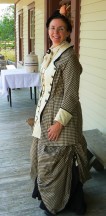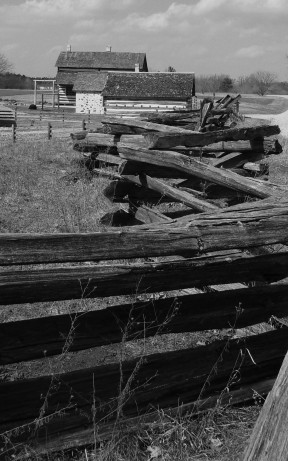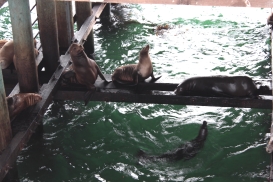Category Archives: Education
Wilderness Week continues!
September 3 marked the Golden Anniversary of the signing of the Wilderness Act into law by President LBJ. I posted a kick-off essay about a recent trip to a designated wilderness preserve here in Wisconsin for The Bardo Group. Subsequently, members of that blogging community posted essays, videos, poetry and photos on the wilderness theme. Check out the daily posts beginning that week by clicking here. Favorite pieces gleaned from that site include How Wolves Change Rivers, The Carpathians – “Europe’s Only True Wilderness”, and In Wilderness Is the Preservation of the World.
Just after my kick-off essay went online, I headed to northern California to visit my family and explore some of the natural places unique to that area. I felt the presence of my father as I re-visited trails we had walked together and that he had walked after I moved out. A quote that I had read somewhere kept surfacing: “In the end, we will conserve only what we love, we will love only what we understand, and we will understand only what we are taught.” Baba Dioum included this thought in a speech he made in 1968 In New Delhi, India, to the general assembly of the International Union for Conservation of Nature.
My father was a teacher of Math and Science professionally. He taught Religion as a volunteer in the church. He taught me many things, but in his teaching about Nature, he was less didactic and more mystic. He simply wanted to be there and to introduce me to a living thing which he loved…the planet.
Some of the things my father introduced me to:
September 21 is the date marked for the People’s Climate March in New York City. The United Nations Climate Summit is two days later. Please consider what your part may be. What do you hope for our planet? How do you want those hopes represented by our nations’ leaders? How can you contribute to the teaching, the understanding, the loving and the preserving of our mutual home? Thank you for doing your part, whatever that may be.
© 2014, essay and photographs, Priscilla Galasso, All rights reserved
Advent Day #20 – Wisdom
Wise and Otherwise
December 20. The 20th free gift of the month is something that can be acquired, but cannot be bought. I don’t think that it can be given, either. The gift is Wisdom. According to Wikipedia, “Wisdom is a deep understanding and realization of people, things, events or situations, resulting in the ability to apply perceptions, judgements and actions in keeping with this understanding.” In other words, “To recognize the significant in the factual is wisdom.” (Dietrich Bonhoeffer) However, “We are made wise not by the recollection of our past, but by the responsibility for our future.” (George Bernard Shaw) And finally, “It is unwise to be too sure of one’s own wisdom. It is healthy to be reminded that the strongest might weaken and the wisest might err.” (Mohandas K. Gandhi)
It would seem, then, that wisdom is something that can be acquired in living with awareness and engaging humbly with experiences. It seems to me, though, that you can’t give someone the benefit of this process. You might point out the process and talk about its benefit, you might set up the beginning of the process, but you can’t impart the journey or the result. It has to be lived. I’m a mother; trust me on this. I wanted to give my children wisdom more than anything, probably for selfish reasons. I wanted to be spared the pain. I wanted to spare them the pain. I asked God to give them wisdom…like on a magic platter descending from heaven…but spare them the pain. Can’t be done. Wisdom is born of pain and suffering and effort and failure. You have to be awake through it all as well. You can’t gain wisdom while you’re anesthetized. I’ve made a great discovery, though. This process is a great equalizer. Keeping Gandhi’s wisdom in mind, my children and I are fellow travelers on this path. We share our stories as friends, we perhaps contribute insights to this process, but we cannot assume the roles of provider and receiver. I try to remember that as I talk to them. It is too easy for me to slip into the “teacher” role and begin to spew language about what they “should” do and what is the “right” way to do something. I often issue too many reminders and begin to sound like I’m micro-managing them. They notice. They mention it. I have to challenge myself to be wiser and trust them to be wise.
I remember the day my father told me that something I said was wise. It felt like a great victory for me. I was 19 or 20. I had been talking to my oldest sister about some article I had read in an evangelical Christian newsletter taking issue with science and carbon dating. My father was eavesdropping from the breakfast room and jumped on the subject by voicing some objection to the fact that the money he was paying for my college education hadn’t stopped me from discoursing like an ignoramus. I was scared of his strong emotion, ashamed of myself, and angry at his insult. Embarrassed and hurt, I fled. We didn’t speak for 3 days. I realized that he wasn’t going to apologize to me or mention the event on his own, so I decided I needed to take the initiative to talk to him about my emotions, clear the air, and try to restore our relationship. I’d never talked to my father about our relationship very much before. He was always right, often angry, and anything that was amiss was my fault. I also knew that he would not show his emotions, that it would be a “formal discussion” on his part, but that I would probably not be able to contain my tears, making me feel foolish and not his equal. I decided to brave the consequences and approach him with Kleenex in hand. I began to talk, and cry, and tell him how I felt. Then he asked me if I wanted an apology. “What do you want me to say?” I told him that part was up to him. My dictating an apology to him would be meaningless. That’s when he said, “That is very wise.” Suddenly, I felt I had grown up and been respected as an equal to my father in some way. What I understood or didn’t understand about evolution and carbon dating and creation didn’t matter to me any more. That I had been able to navigate emotions with my father and repair a broken relationship was far more significant.
Dad & me in 1992. Photo by my 8 year old daughter.
Wisdom isn’t easy to get, but it is available. If you pursue it, you’ll probably get it eventually. It’s completely avoidable, though, if you so choose. I know which way I want to go, so I’ll keep paddling my canoe and checking the horizon. For those of you heading the same way, STEADY ON! I salute you.
Weekly Photo Challenge: A Day in My Life
This week’s photo challenge, A Day in My Life, is a great opportunity for me to tell my readers about my New JOB! I have completed two days of training at Discovery World in Milwaukee, and although I haven’t taken any of my own pictures, you can see some on their website. In addition to my job in Guest Services at this museum, I will also begin working two days a week at Old World Wisconsin at the end of next month as a Costumed Historic Interpreter. This means that I get to do weekly time travel, from the 19th Century into the Future, and talk to folks of all ages about how things work, how we work, what we do with what we know, and what wonderful things are all around us! I think it’s pretty cool that someone’s willing to pay me to do that. And when I get home, I photograph, describe, list and sell all kinds of old and new stuff on eBay.
Favorite elements of my new job: hearing the screech of seagulls on the Lake, matching my breathing to the pace of fish in the aquarium (ever notice how flying ducks are always in a hurry and fish rarely seem to be?), watching a 5-yr-old stroke a Pencil Urchin with 2 small fingers, and seeing a kid’s face light up when he lands his plane in the Flight Simulator. I am looking forward to getting a deck tour and cruise on the SV Denis Sullivan when the ship returns from the Caribbean and taking in a film at the outside amphitheater at dusk during the summer.
Examining Entitlement – the “Feed and Frustrate Formula”
I am working on finding The Middle Way in my life and on communicating what I can of that journey to anyone who might find that helpful…with my own children in mind as always. The other day, I came up with a phrase that I am finding useful in describing the continuum of experiences needed to grow and develop as a person: “Feed and Frustrate”. We all need a certain amount of feeding, starting in infancy when we are in our most dependent phase, and continuing through adulthood. We have physical needs, emotional needs, and intellectual needs. How do you determine what is a ‘need’ and what is a ‘want’ and what that certain amount actually is? That’s a good question and leads to examining entitlement, which I will get to in a moment. I want to take a look now at the other end of the continuum and describe our need for frustration.
Frustration, challenge, resistance, a force up against we must push is a very necessary part of development. Consider the emergence of a butterfly from its cocoon. Many well-meaning folks have discovered a curious thing. If, in their effort to be kind to animals, they assist a butterfly in its struggle to free itself from the structures surrounding it, the insect will weaken and die. The butterfly needs the activity of straining to get fluids moving to its wings, to strengthen them for flight and to dry them out. A similar thing happens if you facilitate a chick in hatching from an egg. The work to chip away at the shell, the time and effort it takes to accomplish that task on its own, is vital to the chick’s health and makes it more robust. Without that hindrance, the chick remains weak. We need to frustrate our children and ourselves enough to stimulate our ability to access our own strengths.
Working out the balance of feeding and frustrating is a lifelong endeavor. I find myself looking at my adult children and wondering how I did as a parent. I became a mom at the tender age of 22 and felt all those biological and hormonal urges to protect, provide, nurture, and “spoil” my kids. I also had a pragmatic sense of limitations. My mom might say that’s the Scotch in me. I am frugal. My kids call me “cheap and weird”. I’m not sure I had a notion of the value of frustration, even though I’m sure I frustrated my kids unintentionally anyway. So, they didn’t get everything they wanted, but I’m not sure I taught them a “work ethic” or a “frustration ethic” very well. I am not sure if my parents taught me that, either. Regardless, the responsibility of developing that ethic is my own. It is the responsibility of each individual to examine their ideas of entitlement and challenge themselves to develop the resources necessary to achieve their goals.
I like to learn through story and art. I think of examples of characters who live out their “feed and frustrate” scenarios and find some tales to be inspiring, some to be cautionary. Too much feeding as well as too much frustration can lead to helplessness and hopelessness. One story I’ve been following lately is that of a young man who is an NBA basketball player in his second year as a pro. I like watching Jimmy Butler play. He has the kind of untapped strength that seems to increase with the number of challenges he’s given. While his teammates recover from injury, he gets to play more minutes, and he seems to be growing up before my eyes. I did some background checking and learned that he was abandoned by his father as an infant and kicked out of his mother’s house when he was 13. A friend’s mom eventually took him into her home and gave him some strict rules to follow…and he blossomed. The feed/frustrate formula made him confident in his ability to improve himself, which he keeps on demonstrating on the basketball court.
This idea is not only pertinent to individual lives, but also to systems. Politically and economically, how are we balancing the feed and frustrate formula in order to support a robust society? Are we giving too much assistance? Are we giving too little? It’s a good thing to re-evaluate over time.
So, perhaps I’ve given you something to think about. How do you see the feed/frustrate balance in your life? Where do you think an adjustment might help? If you’re a writer, what is happening on this level in the story you’re working on now? How does that dynamic work in your characters’ lives? Thanks for listening to me hash out my thoughts!
And one more point. “Ahem! This theory, which is mine…” footnote reference to Monty Python sketch featuring Miss Ann Elk...I own it and it’s mine. I might use it in an article or something. If this gives you an Aha! moment and you want to share it, please reference this blog post. Thanks for your respect!
Oh! The Humanity!
Internet news gives me a stomach ache. I just feel sick after browsing through photos and videos and stories about cruelty, stupidity, fear, and all kinds of petty, human activity. I really appreciate bloggers and others who post genuine evidence of our more noble capabilities. Although, sometimes this is attributed to “angels among us” or some non-human inspiration. Is kindness not a human trait? Justice? Wisdom? What do we gain by hesitating to credit people for exhibiting these admirable qualities and then splashing our media with all the “awkward” examples we can fit on a screen? Bleh…I just feel like I’ve been gorging on rancid movie popcorn. Humans plugged into more and more machinery, morphing into robo-sapiens, give me the same sour taste.
Please, somebody show me a living mensch! A human being, acting gracefully. Are there so few left? Browsing through my photo file, I realize that only a handful of pictures actually contain people. Is it because I find beauty in nature and form and so rarely in mankind?
Here’s one I did uncover. I took this shot last March. It shows a retired thespian giving a presentation to school kids on the process of making maple sugar one hundred years ago. He’s describing hand made tools, telling the story as if he were remembering his boyhood. He peppers his talk with jokes to make the kids laugh and pay attention. He is a teacher of old ways, engaging with new minds, passing on a respect for trees. He’s not doing it for remuneration or applause, he’s doing it because it’s important to him. And I think he’s a good example. Can you show me others? My stomach will thank you!
Weekly Photo Challenge: Geometry
I loved Geometry. As a freshman in High School, I was brand new to California and scared to death. I sat in the front row of Mr. Duport’s class and paid close attention. He was young and funny, and his students liked him. He made the classroom a comfortable place. He wrote in my yearbook at the end of the year how he enjoyed seeing me change into a sociable girl who talked to her classmates and spent less time with her head down in her proofs. I met him again at the 20th class reunion, and he remembered me fondly as smart and interesting…although perhaps that enthusiasm was aided by a few drinks. Anyway, Jim Duport, thanks for the memories.










































